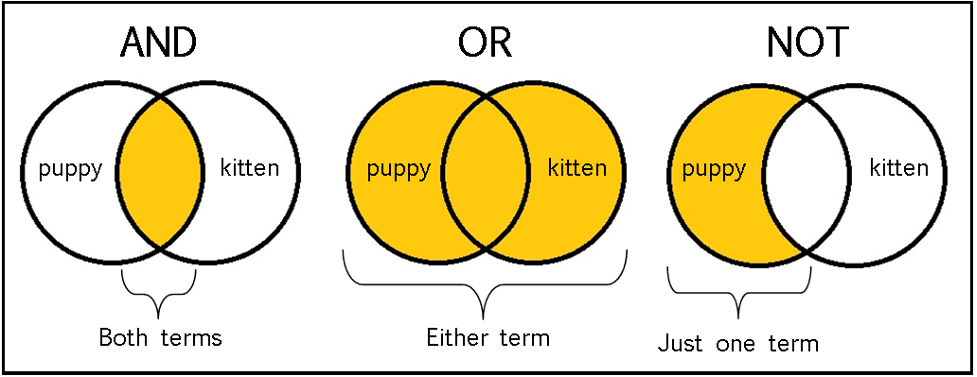52 Searching for Sources
In the Information Age, we have access to an overwhelming amount of information. Where should we even begin to look for answers to our questions? A quick internet search brings back more information than we can possibly read or understand in a lifetime. Because these results are usually ranked by relevance to our search terms, the first results are often the ones we spend the most time with. But these results are affected by our location, previous searches, and maybe even our social media activity. We probably never get a truly objective list of results, and realizing this is an important aspect of information evaluation. We will discuss some aspects of evaluating information in the next section, but for now it is useful to realize that all information is situated in relation to other information.
One common tool you can use when searching in databases or the open web is “Boolean logic,” which borrows from the work of 19th-century Irish mathematician George Boole. The idea is that terms can be connected with “Boolean operators” to control the kinds of results that come back to you from a set of organized information. The most common of these, and perhaps the most useful, are words you use every day: AND, OR, and NOT.
| The AND operator works by requiring that two terms appear together. Dogs AND cats would bring back an article that contains the term dogs and the term cats. If an article contained the term dogs but not cats, the result would not be returned.
The OR operator brings back any article with either term. Dogs OR cats would bring back articles about dogs or cats, regardless of whether the article contained both terms or not. The NOT operator excludes the second term. Dogs NOT cats should only return articles that mention dogs. If it mentions cats, it would be excluded. |
Quotation marks are also very useful in searches. Most databases and web search engines recognize quotation marks to mean that the terms within them must appear all together. For example, the phrase “pumpkin spice coffee,” when placed in quotation marks, tells the search engine to treat the three words as one phrase. Only results containing the exact phrase as it appears in the quotation marks should be returned. An article that mentions pumpkin spice cakes (but not “pumpkin spice coffee”) would be excluded from this search.
By using the Boolean operators and quotation marks, you can really control your searches more carefully so that you end up with more of what you may need for your projects. Look at this example, which uses puppies and kittens to illustrate Boolean operators.

In the AND diagram, your search would return results only if they included both puppy and kitten. The OR diagram shows that either term individually, or both together would satisfy the search—this strategy would result in articles with the term puppy, kitten, and articles including both terms. NOT, in this example, excludes kitten. In the NOT diagram, results are only returned if they contain the term puppy, excluding results for kitten even if puppy is present in that same article.
Attribution
Boolean terms image from “Information Literacy in Action.” OER Commons. https://sites.google.com/a/onalaskaschools.com/tech/boolean-search-tools
